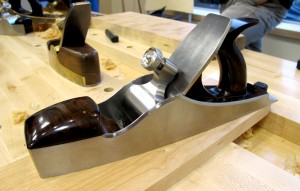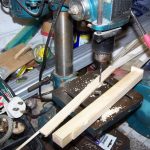We may receive a commission when you use our affiliate links. However, this does not impact our recommendations.
Whether you love them or hate them, the English form of the infill plane has remained almost unchanged since it was invented in the 19th century.
An infill plane is a metal shell that is stuffed – or infilled – with beautiful wood that supports the iron and helps you grip the tool.
Perhaps this form was so exceptional that few people saw fit to mess with it. The Scottish made some flashy adjustments to their custom infills. And the Thomas Norris company added a famous adjuster. (And yes, I know about the Roman planes and iron-lined 18th-century planes that were the forerunners of the infill.)
But other than some small improvements, infills have been infills. In fact, during the 20th-century renaissance of infill planes, most makers have copied or have been heavily influenced by the traditional forms.
So all this pretext is to say that Konrad Sauer is going to go down as a major innovator in the design of infills – or perhaps his efforts will be an an interesting but evolutionary dead end. In 2011, one of Sauer’s customers challenged him to reinvent the traditional panel plane, a tool that has all the sexiness of a crusty Victorian governess.
It has a front bun that is a flamboyant representation of classic moulding design. It has four sharp corners on the front bun that are beautiful, upright and completely blood-letting. The sidewalls of the plane are a combination of traditional (and beautiful) classical curves. The rear tote of the tool is like a classic razee plane. It’s a good-looking form, like a traditional Hobart kitchen mixer – but is not something you would do shots with on a Saturday night.
Sauer redesigned the tool so it looks like a 1950s car blazing down the highway and blowing the doors off the upright Victorian velocipede version that so many people love.
The front bun is low and menacing – sloping like the head of a shark ready to speed forward and take a bite out of your mahogany. And all the other lines of the tool are sympathetic to this dynamic. Even the lines of the tool’s lever cap are beveled in a way to suggest that this plane should be pushed forward – at every opportunity.
Last week I had the privilege of visiting Konrad’s shop in southern Ontario and taking his new plane – called the K13 – for a lengthy test drive. I went into the situation fairly skeptical. I do not love the traditional form. I actually think it’s fairly useless. So redesigning a useless form such as a panel plane is like trying to make an old meat grinder into an object of lust.
But that is exactly what Konrad has done. The K13 is a crazy success in my book. It turned a Mary Poppins-type plane into a Katy Perry tool that makes your heart beat faster. And in the process Konrad made a tool that is lighter in weight and far more usable than the ponderous panel planes of the past.
I’ll be writing more about Konrad’s new K13 in an upcoming issue of Popular Woodworking Magazine. But until then, take a look at the plane in this video and listen to Konrad talk about it in this short video.
— Christopher Schwarz
Do you like handplanes? Then don’t bother reading any further. Do you love handplanes? Then I recommend you take a look at the book I spent five years writing: “Handplane Essentials.” It is a massive brain dump on this form of tool. Hardbound. Printed in the United States. Sweet dust jacket. And the information is good, too. Get it here in our store before this press run runs out (this is a hint).
Here are some supplies and tools we find essential in our everyday work around the shop. We may receive a commission from sales referred by our links; however, we have carefully selected these products for their usefulness and quality.










Chris,
How was a traditional panel plane used and does curving the sides work against it in any way?
You said: I recommend you take a look at the book I spent five years writing: “Handplane Essentials.”
Due to budgetary constraints I tried to find this book at our library but it’s not there. It’s a very large library with multiple branches. They had your first book on workbenches but that’s it. The next county over also has a large library system, but they have no books of yours. I did find a 2010 book by Scott Wynn on hand planes that looks very good so far. I will submit your book as a suggested purchase to our library. Not sure how long that process will take.
What Konrad has done is amazing. The plane looks beautiful at first look and the attention to detail is astounding.
I mentioned this on Konrad’s blog, but want to applaud him for using a ‘sane’ numbering system which hearkens back to Millers Falls (my favorite of the bench planes). What I’m going to mention next may come from left-field, but I’m surprised no one else has mentioned it.
Successful industrial design, in handtools, is something very rare. As I was watching the video, I recalled other notable advancements to industrial design for handplanes, and again I recalled Millers Falls — the “Buck Rogers” bench plane.
Konrad’s has curved sides, but if you remove the front knob from a MF Buck Rogers ( http://oldtoolheaven.com/bench/benchimg/Buckad.jpg designed by Huxtable http://www.google.com/patents?id=zH5wAAAAEBAJ&zoom=4&dq=patent%3AD159339&as_psrg=1&pg=PA1#v=onepage&q&f=false ), and replace it with an infill bun, you get a plane very close in profile view.
Similar sleek designs earlier by Oxhandler at Sargent: http://www.datamp.org/images/24525-1.jpg
Konrad has pushed this concept even further. He’s taken it to the infill arena, questioned what is required/essential, and modernized a traditional design.
I am really excited to see progress like this, and new designs to traditional woodworking tools — and any craftsman with that much attention to detail. Bravo.
-Brett
I like the lines of the plane, but panel planes had straight soles for a reason – you could check how flat your board was.
Very cool plane. Wow. It is about time one of the “exotics” took on the traditional form.
Chris,
Thanks for sharing this. It’s always nice to see a well done take on a classic, and this appears to one of the better attempts I’ve seen. I’ve noticed a lot of recent interest on the local woodworking forums about infill planes, especially as a way to use spare bases that one finds.
Andrew
Not so sure about the Katy Perry thing, but one thing I am sure of, this has to be one of the coolest planes out there, I am more of a car guy than a boat guy, so Porsche 356 Speedster does it for me.
I too am venturing to Konrad’s shop to pick up a couple of new planes next week and I can’t wait, my planes however will be more traditional in an A1 Panel and a No 7. Shoulder Plane – I can’t wait. I hope to take the K13 for a test drive as well!!!
I am thinking Angelina Jolie all the way. 😮
Great Gorgeous Gravy. Time to sell a kidney.
The whole plane reminds me of a Chris Craft more than a car. Stunning piece of design.
Focus on the Katy reference if you like. Me, I’m happy focusing on the plane. Nice!
(Though I won’t argue that Grace Kelly is a better goal to strive toward.)
Speaking as an Industrial Designer, that is a stunning piece of design! Konrad is a remarkably gifted guy.
Speaking as a woodworker, I want one.
Speaking as a mid-to-late 40’s male, maybe Grace Kelly or Veronica Lake comes to mind, but Katy Perry?
Baby you’re a firework!
katy Perry? Seriously?
Konrad’s plane deserves much better than that.
That’s the sexiest plane I’ve ever seen. Wow.
It looks like a Wally 118 somehow mated with Giesel Bundchen.
And just as exciting was to hear Konrad say he ditched the cap iron.
I’m gonna need a moment…
Katy Perry? Seriously?